With these safety tips, learn how to build a campfire (and keep children safe) while camping and on bonfire night.
Below you can learn how to build a campfire and keep everyone safe around the campfire on camping trips and on Bonfire Night! Campfire safety tips are especially important to teach children.
As the sister to Smokey the Bear himself (my baby brother was a California Park Ranger for 15 years), and as someone that worked for L.A.C.O Fire Dept. for 20 years, I know firsthand how dangerous bonfires can be and how quickly wildfires can get out of control.
Both my mother and brother’s homes burned down in the worst wildfire in California’s history–the Paradise #campfire. They escaped with only their pets and the clothes on their backs but made it to my house to hunker down that day. So I sort of know what I’m talking about.
Related: Outdoor Learning and Nature Activities for Kids
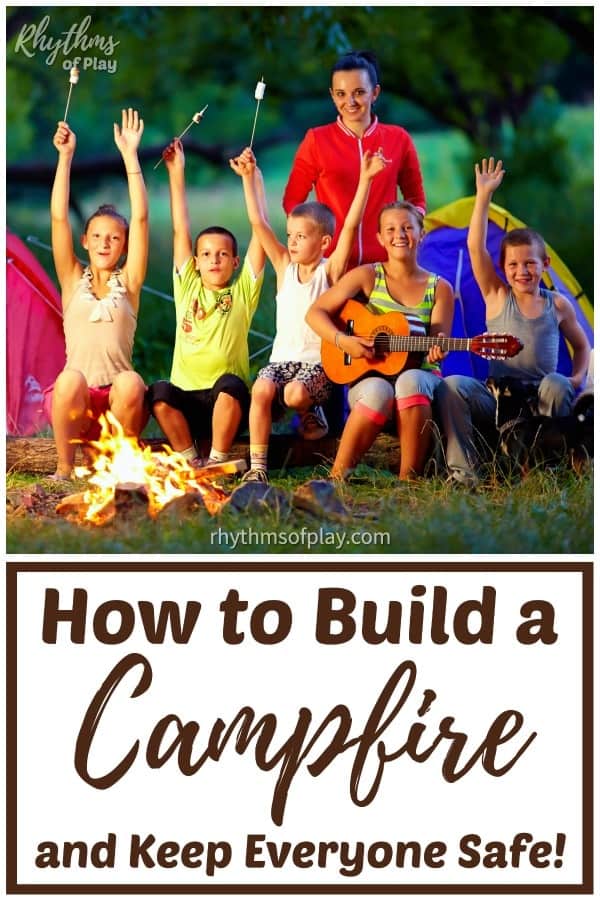
Related: 15 Reasons to Climb a Tree and Other Benefits of Risky Play
How to Build a Bonfire Or Campfire
Learn the best way to build a campfire, start a campfire, and keep a bonfire burning safely with the step-by-step how-to tutorial below.
Step 1 – Choose dry hardwood to build a bonfire or campfire.
- Use hardwood to make a campfire or bonfire.
- Softwood, such as pine, is more likely to throw off sparks that can quickly burn someone or start a wildfire.
- Hardwood, such as oak, is dried or cured to avoid this danger.
- Never cut live trees or branches from trees. Green uncured wood produces more smoke, smaller flames, and produce less heat for the campfire.
Step 2 – Pick a safe spot to build a campfire or bonfire.
- Check with local authorities about when and where bonfires are allowed in your area. You may need a fire permit. Some counties only allow bonfires in designated areas at certain times of the year.
- Dig a shallow pit surrounded by bricks or stones, or use a designated fire pit for your campfire or bonfire. (This will keep the fire from spreading.)
- Prevent wildfires–keep campfires away from trees, shrubs, tents, homes, or other structures.
- Double-check to ensure that your campfire location is not under tree branches.
- Build a bonfire in a spot with no dry brush around. Clear the area around your campfire at least 10 feet from your fire pit.
Step 3 – Build the campfire or bonfire.
- Make a tipi with a few pieces of dry hardwood.
- Place dry tinder (newspaper, twigs, leaves, bark, pine needles, etc.) and kindling inside and around the hardwood tipi.
Step 4 – Start the campfire and keep it burning safely.
- Light the tinder on fire. (Do not use fire accelerants.)
- Add wood to the campfire slowly once the fire is well established.
- Continue adding wood pieces to the bonfire to keep the campfire burning steadily instead of making the bonfire bigger.
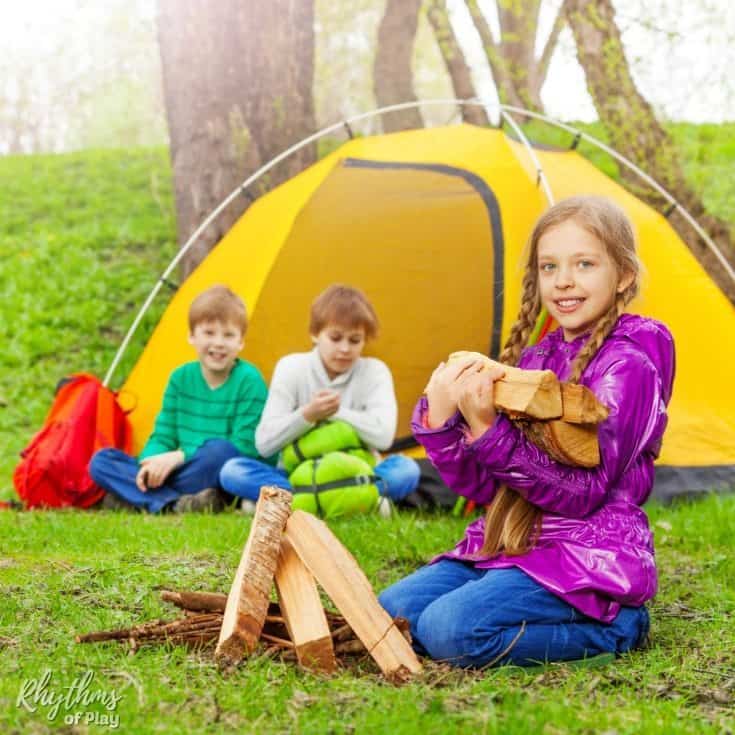
Bonfire Night and Campfire Safety Tips
There are many things to keep in mind to keep everyone safe around a campfire and on bonfire night, especially when there are children present. Smokey the Bear, my park ranger brother, helped me compile these camping and bonfire night safety tips just for you!
Bonfire Night, or Guy Fawkes Night, is commonly celebrated on November 5 in the United Kingdom. Learn more about Bonfire Night UK HERE!
Related: Books That Teach Kids Important Life Lessons
1. Never use green, damp, or softwood to make a campfire or bonfire.
- As mentioned in “How to build a campfire,” softwood is likelier to throw off sparks that can quickly burn someone or start a fire.
- Green and damp wood should also be avoided because of the smoke that it can produce.
- Hardwood, such as oak, is dried or cured to avoid this danger.
2. Supervise children (and pets) near a bonfire at all times.
- Never leave kids (or pets) unattended near fires.
- Once again, never leave children, pets, or adults that act like giant children (you know who they are) unattended near fires–lol!
3. Teach children how to be fire-safe around a campfire or bonfire.
- Assume it’s hot–teach your children to assume anything and everything around a fire is hot. Even the metal on the chairs we sit on can become hot enough to cause a first-degree burn.
- Keep a safe distance–teach your children to keep a safe distance from the fire unless they are roasting marshmallows under the direct supervision of an adult.
- No horse-play or horsing-around near a fire–Accidents are more likely to happen when people and children are messing around and getting crazy. Choose a responsible party to help keep everything away from the fire.
- Don’t poke at or throw anything into the fire–Do not allow your children to poke anything into the fire or throw anything into the fire, or someone is likely to get hurt.
- Teach children what to do if they catch fire–stop, drop and roll.
- Amy from Around the Thicket made a fantastic suggestion in the comments below. Create a bonfire play session around a pretend campfire
before a real fire is involved as a fun way to teach children how to be fire safe.
4. Keep your bonfire or campfire safely contained
Know how to keep a campfire safely contained, and choose a responsible adult (not consuming alcoholic beverages) to keep the fire safely contained at all times.
- Never leave a bonfire unattended.
- Pay attention to the wind direction and strength.
- Keep it safe, small, and manageable.
- Add pieces of wood to keep it burning steadily instead of making the campfire bigger.
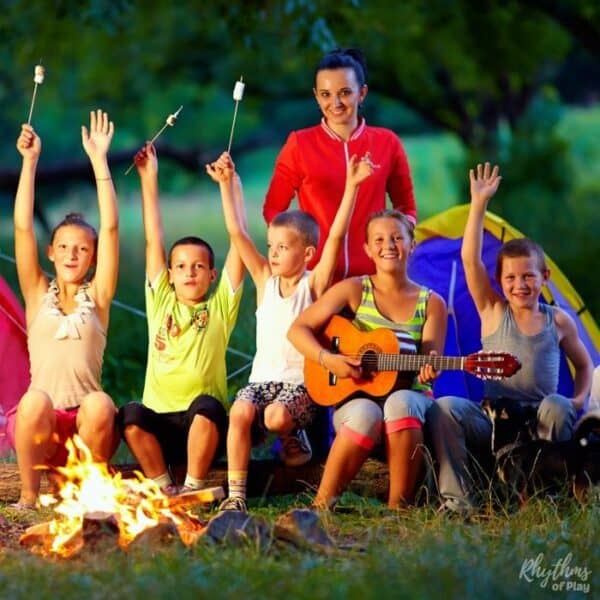
5. Keep a hose or buckets of water and blankets nearby.
It’s always best to be prepared in case of an emergency. Bonfires and campfires can get out of control quickly when we don’t take proper safety precautions.
Have a hose or buckets of water nearby and/or fire-safe blankets to throw on the bonfire or anyone that catches on fire.
6. Know Basic First Aid for Burns
Even when we are following all safety protocols, accidents happen. Having first aid skills and knowing a little about treating burns can help keep everyone safe and happy on bonfire night.
Burn First Aid:
- Run cool (not cold) water over a minor first-degree burn for 10-15 minutes. You can also use a wet towel or item of clothing. Once burned, the skin will continue to burn until it is cooled. Cool water will help stop the skin from continuing to burn.
- Leave small blisters alone. Do not break them open or pop them.
- In the event of a more severe burn. Cover the wound with a cool, moist sterile bandage (or a clean cloth) and call 911 or transport immediately to the nearest hospital.
7. Know how to properly extinguish a bonfire or campfire
How to put out a campfire safely:
- Allow the wood to burn completely to ash if possible.
- Pour lots of water on the bonfire to drown all embers.
- Pour water into the campfire until the hissing sound stops.
- Stir with a shovel until everything is wet and cool in the bonfire pit.
- Alternatively, you can use dirt but don’t bury the campfire. A buried fire can continue to smolder until it reaches its roots and can eventually cause a wildfire. Stir the dirt just as you would water. Dirt will take a lot longer to cool.
- Remember, as smokey the bear says, “If it’s too hot to touch, it’s too hot to leave.”
8. Keep everyone safe while they enjoy campfire food, songs, and stories
Nothing is better than sitting around a bonfire with friends and family enjoying stories, jokes, songs, good food, and good times. Make sure you have food on hand to enjoy, and don’t forget the marshmallows and marshmallow skewers.
It is best to cook over hot coals than a fire. Use cookware safe for fires and follow safety protocols to keep from getting burned. I know too many people that have burned themselves trying to pull food off a fire. Please be safe and enjoy yourself.
Best Bonfire songs for Kids
A bonfire is not complete without a few of the best campfire songs! Click on the link to see the suggested bonfire songs for children below.
- 8 Campfire songs your kids will Love! | Today’s Parent
- Kids’ Music that won’t Drive You NUTZ!

Camping and Bonfire Night Safty Tips
We realize that there are many things to remember when camping and celebrating bonfire night with kids. Bonfires are always best when everyone goes home (or to bed) safe and happy. Following these simple bonfire safety tips makes that a lot more likely. Be fire safe!
Bonfire Night, or Guy Fawkes Night, is commonly celebrated on November 5 in the United Kingdom. Learn more about Bonfire Night UK HERE!
If you are looking for fun camping activities to do with the kids, be sure to check out this round-up of fun outside activities for kids.
You may also like this collection of nature crafts and art activities that use natural materials that are fun to make on camping trips and about the campfire.
Learn more about Rhythms of Play HERE!
If you liked campfire and bonfire safety tips, you might also like:
- Rock Balancing Stone Stacking Art for Kids
- How to Raise a Helper
- Year-Round Gratitude Activities and Crafts for Kids
- 8 Reasons I Allow My Child to Go Barefoot
- 15 Reasons to Climb a Tree and Other Risky Play Benefits
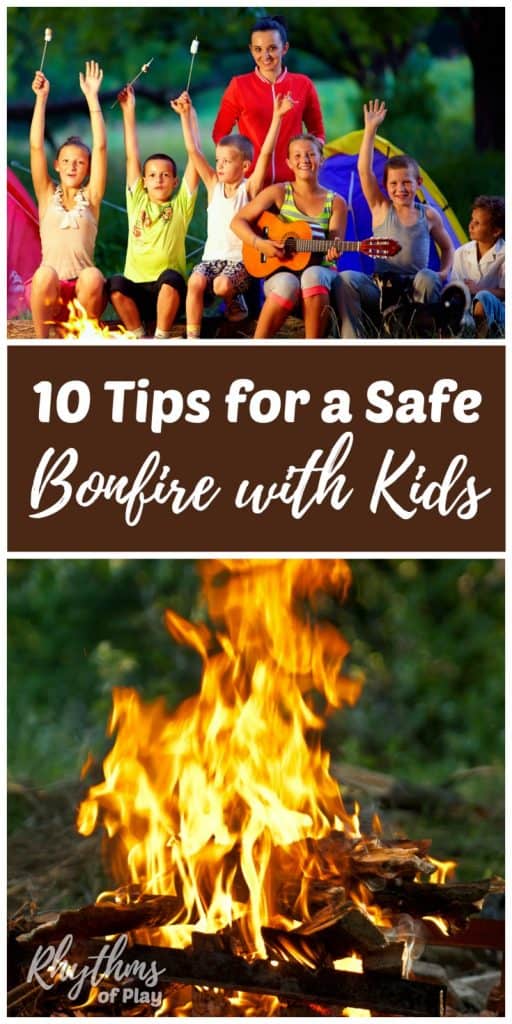

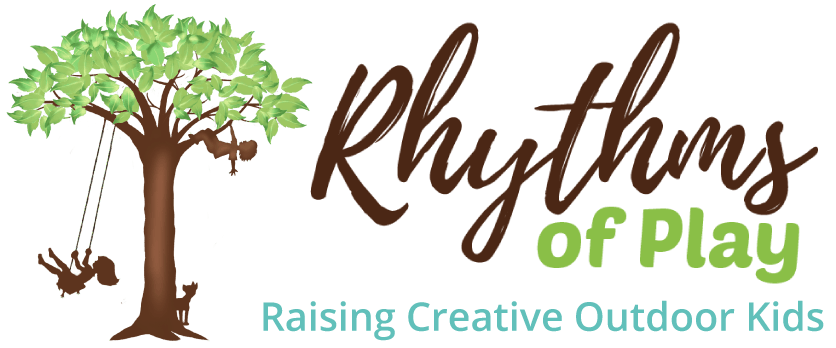
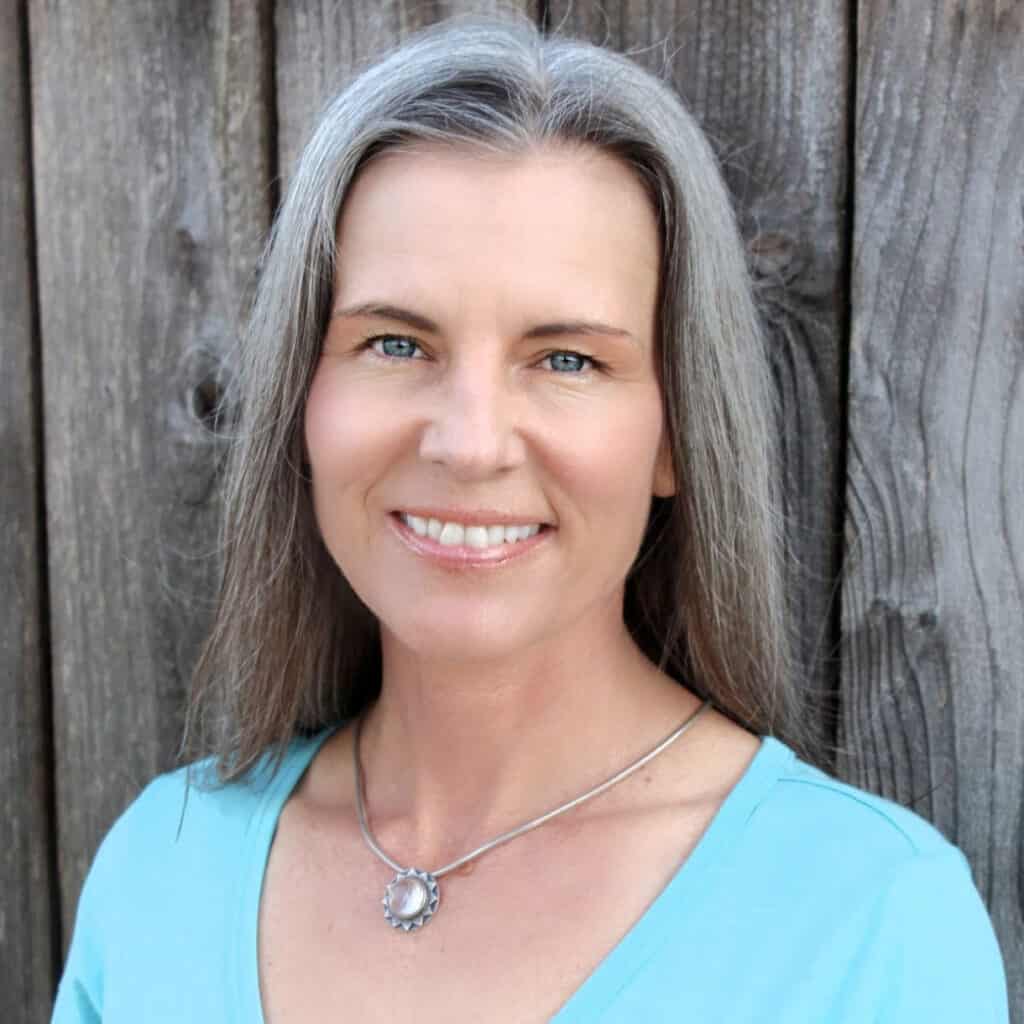

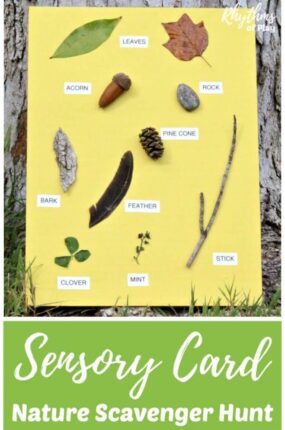
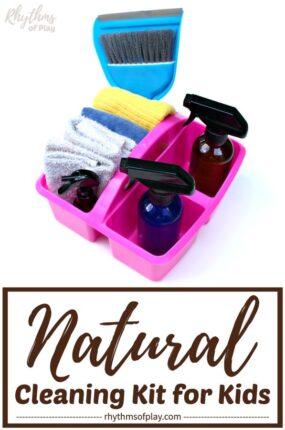
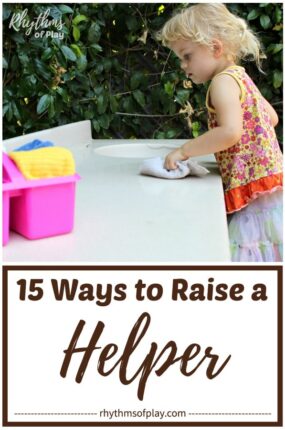

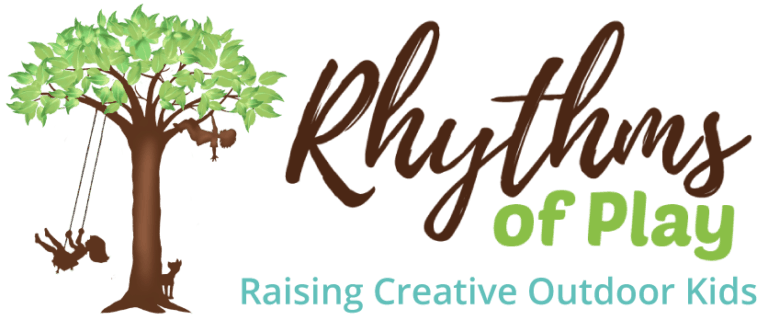
Something I’ve seen in books on forest schools is to build a pretend fire with the children and teach them the rules as you play together – before there is a real fire involved!
That is an EXCELLENT tip Amy! Thank you so much for sharing it!